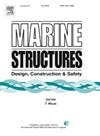Design of a quick-connection device for installing pre-assembled offshore wind turbines
IF 4
2区 工程技术
Q1 ENGINEERING, CIVIL
引用次数: 0
Abstract
Higher wind velocities and lower wind shear are two motivations driving the development of floating offshore wind turbines (OWTs). However, such designs suffer from high expenses and complicated installation scenarios. Installation of offshore wind turbines is challenging due to the unpredictable nature of the environment and the technical complexities, especially at offshore sites. Mating of OWT on top of the pre-installed substructure is one of the critical stages of the installation operation. Grouted, welded, and bolted connections are utilized conventionally, but all have shortcomings. Welded and grouted connections suffer from fatigue forces, while a bolted connection requires minimal installation tolerances and sensitivity to impact forces. The design of a quick connection device (QCD) is expected to reduce the installation time, expand the operational weather window, and overcome the limitations of the earlier connection devices.
The QCD described here comprises conic cross-sections, circular plates, and stiffeners connected to the floating substructure and OWT. This research uses a global model to estimate the relative velocities and displacements between the OWT and spar buoy. Furthermore, a local finite element model is developed to assess the influence of the impact forces and the design of the connection device. Implementing the hydrostatic stiffness of the floating spar within the impact simulations improved the simulation fidelity and reduced the impact damage. Different impact scenarios are performed, and the sensitivity of impact damage concerning the distribution of impact initiation points is assessed. Furthermore, an active control mechanism is used to reduce the relative motions between the installation vessel and the floating substructure. It is concluded that utilizing the anti-swing active control system minimizes the impact velocity and impact damage. This research can be extended by optimizing the design of the quick connection device.
设计用于安装预组装海上风力涡轮机的快速连接装置
更高的风速和更低的风切变是推动漂浮式海上风力涡轮机(OWTs)发展的两大动力。然而,这种设计存在成本高、安装复杂的问题。由于环境的不可预测性和技术的复杂性,海上风力涡轮机的安装具有挑战性,尤其是在近海地点。将海上风力涡轮机安装到预安装的下部结构顶部是安装操作的关键阶段之一。传统的连接方式有灌浆连接、焊接连接和螺栓连接,但所有连接方式都存在缺陷。焊接和灌浆连接会受到疲劳力的影响,而螺栓连接则要求最小的安装公差和对冲击力的敏感性。快速连接装置(QCD)的设计有望缩短安装时间,扩大作业气象窗口,并克服早期连接装置的局限性。此处描述的快速连接装置由圆锥截面、圆板和与浮式下部结构和 OWT 连接的加强筋组成。本研究使用全局模型来估算 OWT 和 spar 浮标之间的相对速度和位移。此外,还开发了一个局部有限元模型,以评估冲击力和连接装置设计的影响。在撞击模拟中采用浮标的静水刚度提高了模拟的逼真度并减少了撞击破坏。对不同的撞击情景进行了模拟,并评估了撞击破坏对撞击起始点分布的敏感性。此外,还采用了一种主动控制机制来减少安装船和浮动下部结构之间的相对运动。结论是,利用防摆动主动控制系统可将撞击速度和撞击损害降至最低。这项研究可通过优化快速连接装置的设计加以扩展。
本文章由计算机程序翻译,如有差异,请以英文原文为准。
求助全文
约1分钟内获得全文
求助全文
来源期刊

Marine Structures
工程技术-工程:海洋
CiteScore
8.70
自引率
7.70%
发文量
157
审稿时长
6.4 months
期刊介绍:
This journal aims to provide a medium for presentation and discussion of the latest developments in research, design, fabrication and in-service experience relating to marine structures, i.e., all structures of steel, concrete, light alloy or composite construction having an interface with the sea, including ships, fixed and mobile offshore platforms, submarine and submersibles, pipelines, subsea systems for shallow and deep ocean operations and coastal structures such as piers.
 求助内容:
求助内容: 应助结果提醒方式:
应助结果提醒方式:


